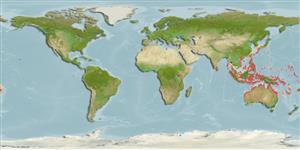Common names from other countries
Environment: milieu / climate zone / depth range / distribution range
Écologie
marin; eau douce; saumâtre démersal; amphidrome (Ref. 59012); profondeur 0 - 5 m (Ref. 86942). Tropical; 22°C - 28°C (Ref. 12468)
Indo-West Pacific: Philippines and Indonesia (also Sunda Is.) through to Micronesia, southern Japan, Papua New Guinea, the Solomon Islands, Vanuatu, Fiji and New Caledonia.
Taille / Poids / Âge
Maturity: Lm ? range ? - ? cm
Max length : 14.0 cm SL mâle / non sexé; (Ref. 48637)
Épines dorsales (Total) : 7; Rayons mous dorsaux (Total) : 8; Épines anales: 1; Rayons mous anaux: 8 - 9; Vertèbres: 25. This species is distinguished by the followingcharacters: no scales between eyes and orbital ridges, IOS 0/1-3/0; jaws reaching back to below front part of eye; absence of auxiliary scales on body; body depth at anal fin origin 13-17% SL (Ref. 130228).
This species is reported to occur in many coastal streams in brackish to freshwaters and estuaries over substrates of mud, sandy mud or leaf litter and is often observed clinging upside down under dead wood, eyes facing downwards. An ambush hunter, feeding mainly on small fish and crustaceans (shrimps (Atyidae), prawns (Palaemonidae)) (Ref. 130228). .Usually found in brackish mangrove areas and in creeks and rivers, sometimes well upstream (Ref. 2847), 48637).
Life cycle and mating behavior
Maturities | Reproduction | Spawnings | Egg(s) | Fecundities | Larves
Keith, P. and M.I. Mennesson, 2023. Review of Butis (Teleostei: Butidae) from Indo-Pacific islands with description of three new species. Cybium 47(4):431-466. (Ref. 130228)
Statut dans la liste rouge de l'IUCN (Ref. 130435)
CITES (Ref. 128078)
Not Evaluated
Menace pour l'homme
Harmless
Utilisations par l'homme
Pêcheries: commercial; Aquarium: Commercial
Outils
Articles particuliers
Télécharger en XML
Sources Internet
Estimates based on models
Preferred temperature (Ref.
115969): 24.9 - 29.3, mean 28.6 (based on 2274 cells).
Phylogenetic diversity index (Ref.
82804): PD
50 = 0.5156 [Uniqueness, from 0.5 = low to 2.0 = high].
Bayesian length-weight: a=0.00617 (0.00312 - 0.01219), b=3.01 (2.83 - 3.19), in cm Total Length, based on LWR estimates for this species & (Sub)family-body (Ref.
93245).
Niveau trophique (Ref.
69278): 4.2 ±0.7 se; based on size and trophs of closest relatives
Résilience (Ref.
120179): Haut, temps minimum de doublement de population inférieur à 15 mois (Preliminary K or Fecundity.).
Fishing Vulnerability (Ref.
59153): Low vulnerability (10 of 100).
